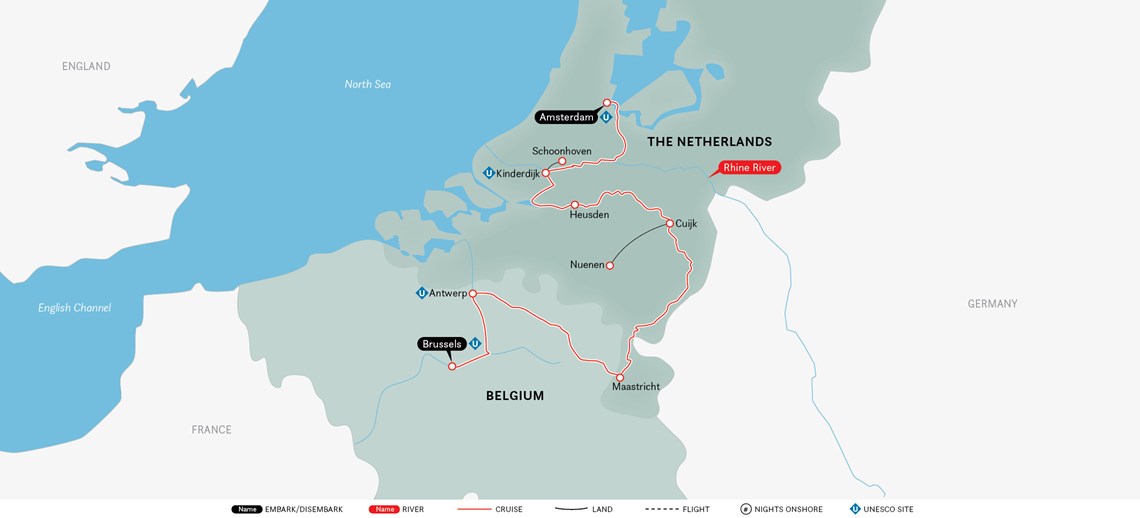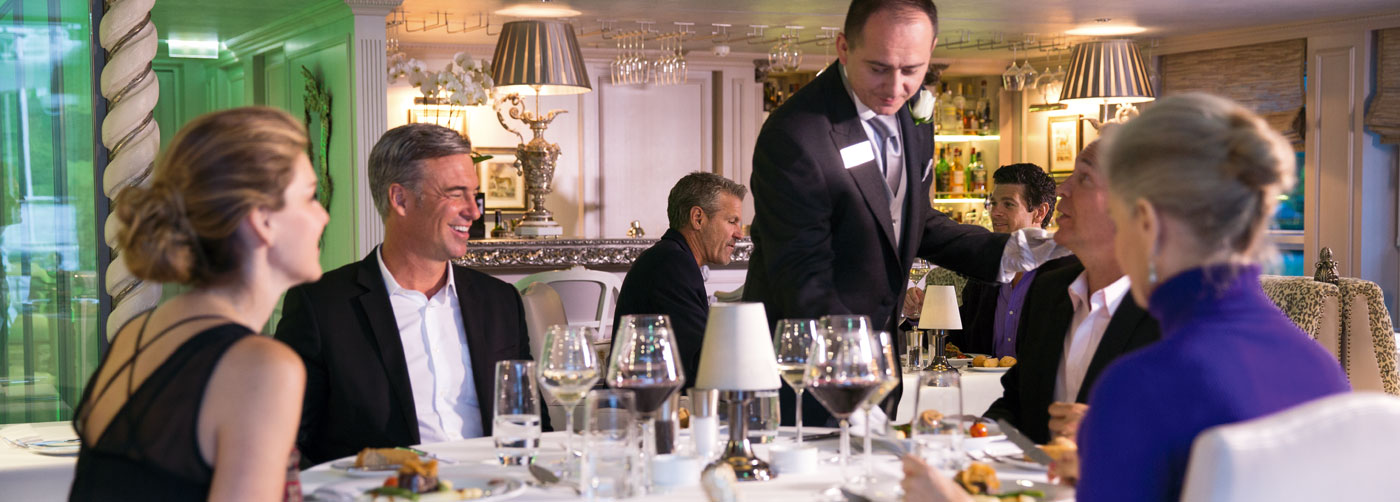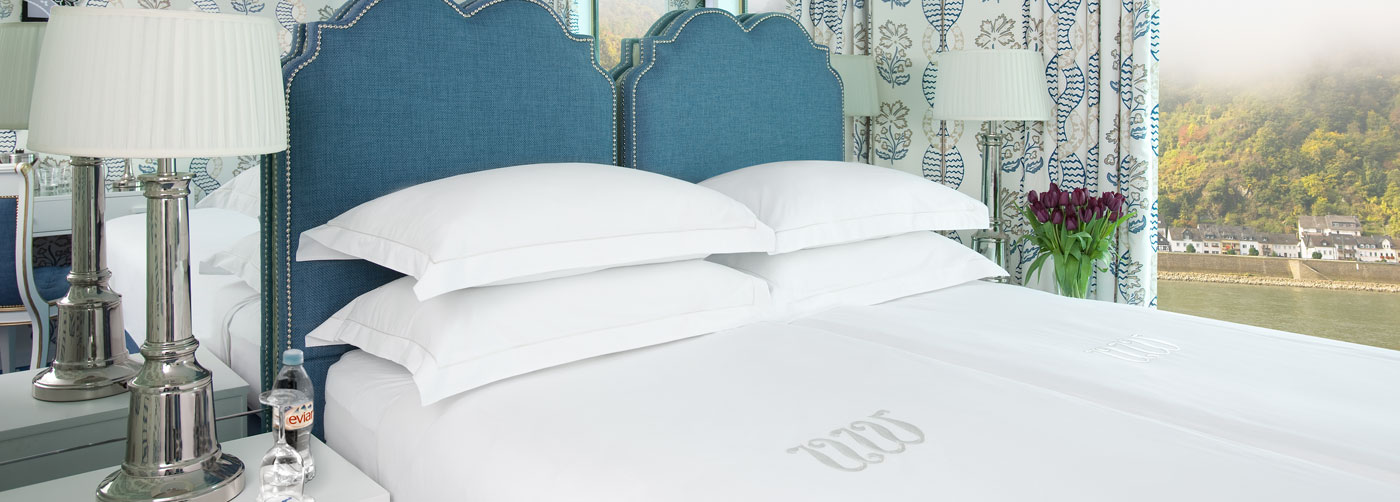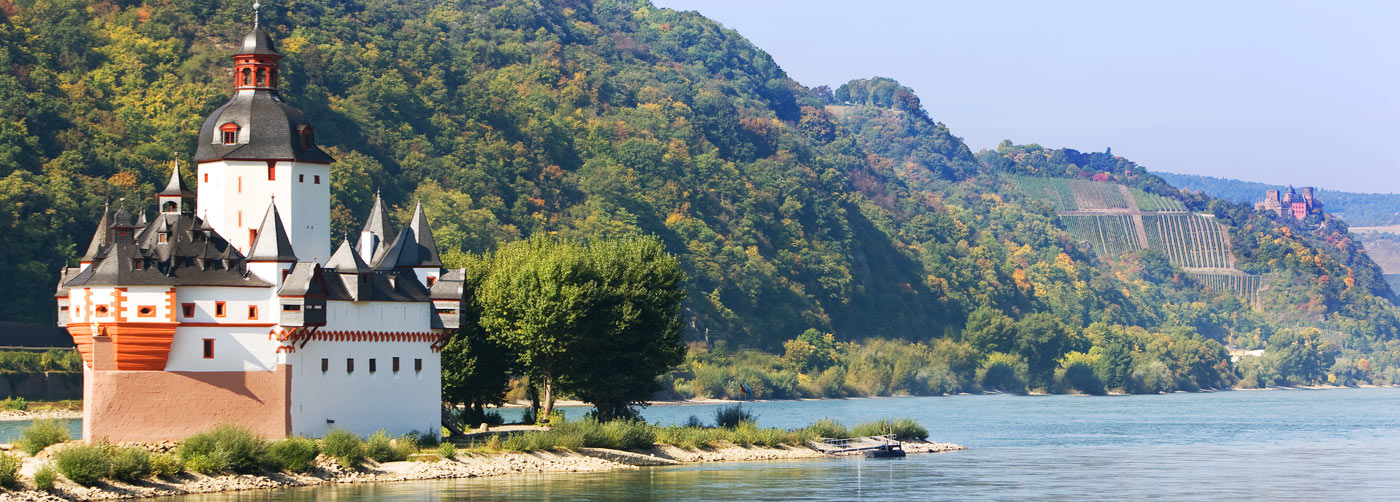Holland & Belgium at Tulip Time (2021)

 This itinerary adds a contemporary flair to the classic tulip time experience, where you’ll find an ideal mix of old and new, historic and modern, in some of Europe’s liveliest cities.
This itinerary adds a contemporary flair to the classic tulip time experience, where you’ll find an ideal mix of old and new, historic and modern, in some of Europe’s liveliest cities.This itinerary adds a contemporary flair to the classic tulip time experience, where you’ll find an ideal mix of old and new, historic and modern, in some of Europe’s liveliest cities. You’ll spend time in Amsterdam and Maastricht, allowing you to discover great shopping, countless active options and mouthwatering foodie destinations. Explore Belgium’s historical and contemporary capital city of Brussels, home of a rich and vibrant culinary tradition. Discover Antwerp’s penchant for tasty treats, including Belgian waffles, beer, pralines and chocolate on a walking discovery tour of the diamond capital of the world. In splendid Maastricht, a city with hundreds of national heritage sites, you’ll uncover why it’s known as one of the most beautiful cities in all of Holland. Follow in Van Gogh’s footsteps with a stroll through Nuenen, where you’ll wander through the sites that inspired much of his art. Or venture into the town of Heusden and marvel at a historic working mill, learn to make bread at a local bakery, or wander through the remnants of a 13th-century fortress. Delight in a visit to Kinderdijk to see it’s 19 well-preserved windmills that have stood the test of time.
Featured Excursion:
- Brussels city tour with chocolate tasting
On our way into the city center, we’ll take you on a panoramic tour of the major sightseeing spots in Brussels, such as the Royal Residence, Chinese Pavilion and Japanese Pagoda. From there, we’ll set out on foot to see the city up close—and taste some iconic Belgian treats along the way!
In the evening, a special Captain’s Welcome Reception and Dinner will be prepared for you.
Featured Excursion:
- Antwerp walking tour with Belgian treats
It may be the diamond capital of the world, but Antwerp is also known for a number of other gems—maybe just not of the rock variety. Step onto the streets of Antwerp and take in the Golden Age art, sip Belgian beer and taste waffles, pralines, fries and chocolates that make Antwerp, Antwerp. This walking discovery tour takes you through the sights, sounds, smells, and yes, even tastes of City Hall, the Market Square and the UNESCO-designated Cathedral of Our Lady, which houses four extraordinary works by one of the city’s most beloved sons—Peter Paul Rubens. Continue on and enjoy tastings of other sorts—a Brussels waffle, local spirit or even the catch of the day as you journey past the Steen Castle, City Hall and the Brabo Fountain, and take an inside visit of the Cathedral all as you walk through the Groenplaats square with its sublime views of the Art Deco Boerentoren.
Featured Excursion:
- “Let’s Go” Maas River biking
Maastricht is the oldest city in The Netherlands and has earned the nicknames “Culinary capital of The Netherlands” and “Europe’s smallest metropolis,” meaning life in Maastricht is full of simple luxuries and what the French would call “joie de vivre.” Part of what makes Maastricht unique is its rich history and change in control. In its existence, Maastricht has been influenced by the Romans, the Spanish, the French and finally the Dutch. Maastricht is just what you’d imagine an old city to be: narrow cobblestone streets, ancient fortifications and town houses from the 17th century. On the other side, in the Wyck-Céramique area, you’ll find all that plus an urban planner’s dream—a mix of contemporary apartment buildings and modern offices. Hop on a bicycle and see the city’s varied past and where other cultures’ influence has remained to this day.
Other Excursions:
Meander through the historic city center of Maastricht with your local guide and take in all of the city’s prettiest sites. During your walk, you’ll discover the picturesque streets of the Stokstraat Quarter and various charming promenades across the old and new city centers. You’ll take a peek into City Hall too see the wall tapestries, stucco, ceiling paintings and mantelpieces inside. As you go, you’ll hear the fascinating stories and amusing anecdotes of Maastricht history, its progression from Roman settlement to early industrial powerhouse and the Mestreechter Geis (or “the Spirit of Maastricht”, which is what they call their local way of life).
More than 8,000 American soldiers lie under white crosses and Stars of David among the rolling hills of Limburg. They died fighting in this area following the Normandy invasion, earning, as the commemorative inscription says, "praise that will never die." A memorial is inscribed with the names of another 1,723 whose remains were never found or identified. It's the only American battlefield cemetery in the Netherlands; infantrymen and pilots, mechanics and bombardiers are interred in this serene and surprisingly uplifting place. Not only Americans visit this memorial. Thousands of families from the Netherlands and surrounding nations come to honor those who fell liberating their countries from the Nazi occupation.
Featured Excursions:
- Heusden “Village Day”
The pretty squares and harbors where pleasure craft bob give little hint of Heusden's exciting past. A water fortress was first erected here in the 12th century, and many a medieval battle was fought in this region. The characteristic star shape of the fortress dates much sooner though, to when the town was founded in 1649 at the end of the Eighty Years’ War that won Holland its independence from Spain.
You may opt for one of four different ways to explore this historic village: bike through the town and the along the harbor with a guide, make sausage-filled rolls (a.k.a. worstenbroodje) with a local baker, taste cheese at a nearby dairy farm or tour the unusual 17th-century fortress.
- Van Gogh “Village Day” in Nuenen with a country lunch
Vincent van Gogh produced 195 paintings and numerous watercolors and sketches in the two years he lived in Nuenen, where his father was vicar; among the work he did here is The Vicarage at Nuenen. His studio was the converted laundry room in that vicarage, which his father did not think was suitable, though he assured Theo van Gogh that they had installed a wood stove, if not a large window (Vincent didn't want one). Here Van Gogh created the character studies that became The Potato Eaters. He wrote to his brother: "It's true that I can't make anything financially from my work here—but I'm making really good friends here—and I believe they'll become even better." Begin at the Vincentre, with its interactive displays about the people the artist knew and the work he produced here, and then walk through the village, taking the routes the painter took and seeing sights he would have seen. He painted three scenic windmills that still stand; perhaps as you enjoy a relaxed country lunch, you'll get a sense of the countryside as the artist experienced it.
Other Excursions:
At one time 10,000 windmills operated in the Netherlands, pumping water away from low-lying lands (much of the country is below sea level) and creating what are known as polders—arable land reclaimed from the water. Though the mighty windmill has been replaced by newer technology, you can see how effective the system was in Kinderdijk, where a group of 19 windmills erected in the 18th century still function. Most are ground-sail windmills (meaning their sails nearly touch the ground as they whirl) and each one was carefully situated to make sure one did not block another’s wind. Each windmill moves the water a little farther, pumping it from field to canal, from canal to river. Climb the steep stairs of a mill and look out over the quiet fields that would be underwater were it not for the ingenuity of the Dutch. (Of course, you can simply admire it from the outside. But if you do that, you won’t see how the mill keeper’s family lived.) These mills are kept in working order partly as a backup in case modern technology fails, and they were used as recently as WWII, when there was no fuel to keep newer pumping stations working.
The charming little town is well known for its tradition of silverwork, which thrives to this day. There have been silversmiths in Schoonhoven since the Middle Ages, and their influence can be found reflected in the current streets and the ancient monumental silversmithing sites. The town is home to several silversmith houses and more than 30 galleries, jewelers and workshops. In Schoonhoven you can also find a Dutch Silver Museum and a craft center where you can admire an impressive collection of old silverware from Schoonhoven. There’s more than just silver, too. Visitors love the picturesque center full of characteristic shops, the beautiful city gate and charming terraces along the Lek river.
Set out on an invigorating bike ride through quintessential Dutch scenery. Beginning and ending in Schoonhoven, you’ll ferry across the Lek river, pedal through the quaint countryside and pass the unique windmills of Groot-Ammers.
Other Excursions:
Rivers of blue hyacinths curve through the trees, and great drifts of brilliantly hued tulips and daffodils carpet Keukenhof’s 70-plus acres (32 hectares). It’s probably the most spectacular flower garden in the world, and it’s only open for a few weeks each spring. Gardeners plant some seven million bulbs on these grounds, making it a showcase for the Netherlands’ legendary flower industry. There’s more to see than just flowers, of course: There are intriguing exhibits in pavilions scattered throughout the estate, as well as concerts and activities for kids. After you’ve seen all of the vibrant blossoms and perhaps even bought some bulbs to grow at home, you’ll meet up with your guide and continue by motorcoach to the ship.
Note: If you’re thinking about buying bulbs from Keukenhof or perhaps having items shipped home, make sure the vendor provides the documentation necessary for the import of bulbs or plants into your home country. Rules for importing flower bulbs and plants vary from country to country.
It’s called the “Venice of the North” for a reason: Canals crisscross the heart of the old city, and bridges link some 90 islands. As the principal city in a newly independent Holland, Amsterdam was a boom town in the early 17th century, rapidly outgrowing its medieval walls. The city’s fathers responded by demolishing most of the old city and building an entirely new one, creating Europe’s first planned city. That “new” district is now 400 years old, and as you glide along the main canals, you’ll pass stately merchants’ houses built centuries ago (some of them are now house museums you can visit on your own). But the canals are not merely scenic; they are essential thoroughfares—people take water buses to work and live in houseboats along the banks—so a canal cruise also gives you a look at the busy modern city.
In the evening, a special Captain’s Farewell Reception and Dinner will be prepared for you.
Other Excursions:
Rivers of blue hyacinths curve through the trees, and great drifts of brilliantly hued tulips and daffodils carpet Keukenhof’s 70-plus acres (32 hectares). It’s probably the most spectacular flower garden in the world, and it’s only open for a few weeks each spring. Gardeners plant some seven million bulbs on these grounds, making it a showcase for the Netherlands’ legendary flower industry. There’s more to see than just flowers, of course: There are intriguing exhibits in pavilions scattered throughout the estate, as well as concerts and activities for kids. After you’ve seen all of the vibrant blossoms and perhaps even bought some bulbs to grow at home, you’ll meet up with your guide and continue by motorcoach to the ship.
Note: If you’re thinking about buying bulbs from Keukenhof or perhaps having items shipped home, make sure the vendor provides the documentation necessary for the import of bulbs or plants into your home country. Rules for importing flower bulbs and plants vary from country to country.
It’s called the “Venice of the North” for a reason: Canals crisscross the heart of the old city, and bridges link some 90 islands. As the principal city in a newly independent Holland, Amsterdam was a boom town in the early 17th century, rapidly outgrowing its medieval walls. The city’s fathers responded by demolishing most of the old city and building an entirely new one, creating Europe’s first planned city. That “new” district is now 400 years old, and as you glide along the main canals, you’ll pass stately merchants’ houses built centuries ago (some of them are now house museums you can visit on your own). But the canals are not merely scenic; they are essential thoroughfares—people take water buses to work and live in houseboats along the banks—so a canal cruise also gives you a look at the busy modern city.
In the evening, a special Captain’s Welcome Reception and Dinner will be prepared for you.
Other Excursions:
At one time 10,000 windmills operated in the Netherlands, pumping water away from low-lying lands (much of the country is below sea level) and creating what are known as polders—arable land reclaimed from the water. Though the mighty windmill has been replaced by newer technology, you can see how effective the system was in Kinderdijk, where a group of 19 windmills erected in the 18th century still function. Most are ground-sail windmills (meaning their sails nearly touch the ground as they whirl) and each one was carefully situated to make sure one did not block another’s wind. Each windmill moves the water a little farther, pumping it from field to canal, from canal to river. Climb the steep stairs of a mill and look out over the quiet fields that would be underwater were it not for the ingenuity of the Dutch. (Of course, you can simply admire it from the outside. But if you do that, you won’t see how the mill keeper’s family lived.) These mills are kept in working order partly as a backup in case modern technology fails, and they were used as recently as WWII, when there was no fuel to keep newer pumping stations working.
The charming little town is well known for its tradition of silverwork, which thrives to this day. There have been silversmiths in Schoonhoven since the Middle Ages, and their influence can be found reflected in the current streets and the ancient monumental silversmithing sites. The town is home to several silversmith houses and more than 30 galleries, jewelers and workshops. In Schoonhoven you can also find a Dutch Silver Museum and a craft center where you can admire an impressive collection of old silverware from Schoonhoven. There’s more than just silver, too. Visitors love the picturesque center full of characteristic shops, the beautiful city gate and charming terraces along the Lek river.
Set out on an invigorating bike ride through quintessential Dutch scenery. Beginning and ending in Schoonhoven, you’ll ferry across the Lek river, pedal through the quaint countryside and pass the unique windmills of Groot-Ammers.
Featured Excursions:
- Heusden “Village Day”
The pretty squares and harbors where pleasure craft bob give little hint of Heusden's exciting past. A water fortress was first erected here in the 12th century, and many a medieval battle was fought in this region. The characteristic star shape of the fortress dates much sooner though, to when the town was founded in 1649 at the end of the Eighty Years’ War that won Holland its independence from Spain.
You may opt for one of four different ways to explore this historic village: bike through the town and the along the harbor with a guide, make sausage-filled rolls (a.k.a. worstenbroodje) with a local baker, taste cheese at a nearby dairy farm or tour the unusual 17th-century fortress.
- Van Gogh “Village Day” in Nuenen with a country lunch
Vincent van Gogh produced 195 paintings and numerous watercolors and sketches in the two years he lived in Nuenen, where his father was vicar; among the work he did here is The Vicarage at Nuenen. His studio was the converted laundry room in that vicarage, which his father did not think was suitable, though he assured Theo van Gogh that they had installed a wood stove, if not a large window (Vincent didn't want one). Here Van Gogh created the character studies that became The Potato Eaters. He wrote to his brother: "It's true that I can't make anything financially from my work here—but I'm making really good friends here—and I believe they'll become even better." Begin at the Vincentre, with its interactive displays about the people the artist knew and the work he produced here, and then walk through the village, taking the routes the painter took and seeing sights he would have seen. He painted three scenic windmills that still stand; perhaps as you enjoy a relaxed country lunch, you'll get a sense of the countryside as the artist experienced it.
Featured Excursion:
- “Let’s Go” Maas River biking
Maastricht is the oldest city in The Netherlands and has earned the nicknames “Culinary capital of The Netherlands” and “Europe’s smallest metropolis,” meaning life in Maastricht is full of simple luxuries and what the French would call “joie de vivre.” Part of what makes Maastricht unique is its rich history and change in control. In its existence, Maastricht has been influenced by the Romans, the Spanish, the French and finally the Dutch. Maastricht is just what you’d imagine an old city to be: narrow cobblestone streets, ancient fortifications and town houses from the 17th century. On the other side, in the Wyck-Céramique area, you’ll find all that plus an urban planner’s dream—a mix of contemporary apartment buildings and modern offices. Hop on a bicycle and see the city’s varied past and where other cultures’ influence has remained to this day.
Other Excursions:
Meander through the historic city center of Maastricht with your local guide and take in all of the city’s prettiest sites. During your walk, you’ll discover the picturesque streets of the Stokstraat Quarter and various charming promenades across the old and new city centers. You’ll take a peek into City Hall too see the wall tapestries, stucco, ceiling paintings and mantelpieces inside. As you go, you’ll hear the fascinating stories and amusing anecdotes of Maastricht history, its progression from Roman settlement to early industrial powerhouse and the Mestreechter Geis (or “the Spirit of Maastricht”, which is what they call their local way of life).
More than 8,000 American soldiers lie under white crosses and Stars of David among the rolling hills of Limburg. They died fighting in this area following the Normandy invasion, earning, as the commemorative inscription says, "praise that will never die." A memorial is inscribed with the names of another 1,723 whose remains were never found or identified. It's the only American battlefield cemetery in the Netherlands; infantrymen and pilots, mechanics and bombardiers are interred in this serene and surprisingly uplifting place. Not only Americans visit this memorial. Thousands of families from the Netherlands and surrounding nations come to honor those who fell liberating their countries from the Nazi occupation.
Featured Excursion:
- Antwerp walking tour with Belgian treats
It may be the diamond capital of the world, but Antwerp is also known for a number of other gems—maybe just not of the rock variety. Step onto the streets of Antwerp and take in the Golden Age art, sip Belgian beer and taste waffles, pralines, fries and chocolates that make Antwerp, Antwerp. This walking discovery tour takes you through the sights, sounds, smells, and yes, even tastes of City Hall, the Market Square and the UNESCO-designated Cathedral of Our Lady, which houses four extraordinary works by one of the city’s most beloved sons—Peter Paul Rubens. Continue on and enjoy tastings of other sorts—a Brussels waffle, local spirit or even the catch of the day as you journey past the Steen Castle, City Hall and the Brabo Fountain, and take an inside visit of the Cathedral all as you walk through the Groenplaats square with its sublime views of the Art Deco Boerentoren.
Featured Excursion:
- Brussels city tour with chocolate tasting
On our way into the city center, we’ll take you on a panoramic tour of the major sightseeing spots in Brussels, such as the Royal Residence, Chinese Pavilion and Japanese Pagoda. From there, we’ll set out on foot to see the city up close—and taste some iconic Belgian treats along the way!
In the evening, a special Captain’s Farewell Reception and Dinner will be prepared for you.
| Cruise Departure | Double Occupancy Pricing | Ship | ||
|---|---|---|---|---|
|
Sun, 21 Mar 2021
(Brussels to Amsterdam) |
$3,199.00 |
River Queen |
Select this date | |
|
Sun, 28 Mar 2021
(Brussels to Amsterdam) |
$3,199.00 |
River Queen |
Select this date | |
|
Sun, 04 Apr 2021
(Brussels to Amsterdam) |
$3,899.00 |
River Queen |
Select this date | |
|
Sun, 11 Apr 2021
(Brussels to Amsterdam) |
$3,899.00 |
River Queen |
Select this date | |
A PHP Error was encountered
Severity: Notice
Message: unserialize(): Error at offset 0 of 730 bytes
Filename: views/price_dates.php
Line Number: 184
- All fares are per guest in US Dollars based on double occupancy unless otherwise noted.
- Fares are capacity controlled and are subject to change at any time without notice.
- Availability of all stateroom categories cannot be guaranteed.
- Single Supplement applies for single accommodation.
- Itineraries, hotels, and vessels may change, and substitute visits to other sites may occur during your trip due to water level fluctuations and other uncontrollable factors.
- The order of sightseeing and docking ports are subject to change according to port authority assignments.
- Prices exclude additional port charges of $200 per person
Dining
- All meals onboard, prepared using the finest and freshest ingredients
- 7 breakfasts, 6 lunches, 7 dinners
- Captain’s Welcome and Farewell Receptions
- Welcome and Farewell Gala Dinners
- Unlimited beverages onboard, including fine wine, beer, spirits, specialty coffee and tea, soft drinks and mineral water

Excursions
- 6 days of excursions, including "Choice Is Yours" options, all fully hosted by English-speaking local experts
- Guided “Let's Go” and “Village Day” programs
- State-of-the-art Quietvox portable audio-headset system on all excursions
- Use of bicycles and Nordic walking sticks

Accommodations
- 7-night cruise in a riverview stateroom on the regal River Queen
- Lavishly appointed riverview staterooms and suites have handcrafted Savoir® Beds of England, high thread count 100% Egyptian cotton sheets and European duvets, and a menu of pillow options
- Free Internet and Wi-Fi access

Experiences
- 2 countries: Belgium and the Netherlands
- 4 UNESCO World Heritage sites
- Services of an experienced Uniworld Cruise Manager
- Captivating onboard local entertainment
- Cultural enrichment, including a Signature Lecture
- All transfers on arrival and departure days
- Gratuities for onboard personnel (ship staff, crew, Cruise/Tour Manager) are included during the cruise/tour






